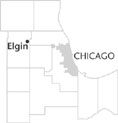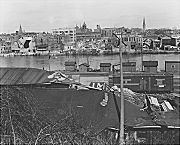| Entries |
| E |
|
Elgin, IL
|
 Kane County, 35 miles NW of the Loop. The future site of Elgin was well known to the
Potawatomi,
for here the
Fox River
could be forded at many times of the year, and there was good fishing in the shallows. Hezekiah Gifford apparently gave Elgin its name after the 1833
Black Hawk War.
By 1837, it already had a bridge and a mill or two, and was beginning to enjoy a certain importance as a stage on the coach route from Chicago to the lead mines of Galena. In 1849, the Galena & Chicago Union Railroad reached Elgin, which later would be served by
railroads
running along both banks of the Fox River, linking the growing town to Chicago and other urban centers. Elgin showed great promise in the 1850s, and in 1856 the Elgin Academy was founded. The town continued to thrive during the 1860s, both as a center of military production during the Civil War and because industrial enterprises began to use the water power of the swiftly flowing Fox River.
Kane County, 35 miles NW of the Loop. The future site of Elgin was well known to the
Potawatomi,
for here the
Fox River
could be forded at many times of the year, and there was good fishing in the shallows. Hezekiah Gifford apparently gave Elgin its name after the 1833
Black Hawk War.
By 1837, it already had a bridge and a mill or two, and was beginning to enjoy a certain importance as a stage on the coach route from Chicago to the lead mines of Galena. In 1849, the Galena & Chicago Union Railroad reached Elgin, which later would be served by
railroads
running along both banks of the Fox River, linking the growing town to Chicago and other urban centers. Elgin showed great promise in the 1850s, and in 1856 the Elgin Academy was founded. The town continued to thrive during the 1860s, both as a center of military production during the Civil War and because industrial enterprises began to use the water power of the swiftly flowing Fox River.

|
During the twentieth century, Elgin has continued to thrive modestly. For a time during the 1920s it was one of the centers for a great network of interurban trains, which linked together the towns of the Fox River Valley and their neighbors to the east. This remarkable system might have continued to grow and to serve the region well, but it was dismantled during the great expansion in automobile travel in the 1950s.
Today the town extends well beyond the original nucleus, with growth along Interstate 90 to the north. Most of its heavy industries have disappeared, but it enjoys a quiet prosperity as a center for commuters and, increasingly, for companies such as Motorola and Bank One. Redevelopment of the downtown area has included the Grand Victoria Casino.
| Elgin, IL (inc. 1854) | |||||
| Year |
Total
(and by category) |
Foreign Born | Native with foreign parentage | Males per 100 females | |
| 1870 | 5,441 | 26.7% | — | 98 | |
| 5,360 | White (98.5%) | ||||
| 81 | Colored (1.5%) | ||||
| 1900 | 22,433 | 24.2% | 36.8% | 89 | |
| 22,238 | White (99.1%) | ||||
| 187 | Negro (0.8%) | ||||
| 8 | Chinese (0.0%) | ||||
| 1930 | 35,929 | 15.3% | 32.5% | 94 | |
| 35,539 | White (98.9%) | ||||
| 310 | Negro (0.9%) | ||||
| 12 | Chinese (0.0%) | ||||
| 1 | Japanese (0.0%) | ||||
| 67 | Mexican (0.2%) | ||||
| 1960 | 49,447 | 4.6% | 18.1% | 91 | |
| 47,795 | White (96.7%) | ||||
| 595 | Negro (1.2%) | ||||
| 57 | Other races (0.1%) | ||||
| 1990 | 77,010 | 12.9% | — | 98 | |
| 60,040 | White (78.0%) | ||||
| 5,588 | Black (7.3%) | ||||
| 122 | American Indian (0.2%) | ||||
| 2,663 | Asian/Pacific Islander (3.5%) | ||||
| 8,597 | Other race (11.2%) | ||||
| 14,201 | Hispanic Origin* (18.4%) | ||||
| 2000 | 94,487 | 23.6% | — | 100 | |
| 66,600 | White alone (70.5%) | ||||
| 6,427 | Black or African American alone (6.8%) | ||||
| 382 | American Indian and Alaska Native alone (0.4%) | ||||
| 3,668 | Asian alone (3.9%) | ||||
| 58 | Native Hawaiian and Other Pacific Islander alone (0.1%) | ||||
| 14,537 | Some other race alone (15.4%) | ||||
| 2,815 | Two or more races (3.0%) | ||||
| 32,430 | Hispanic or Latino* (34.3%) | ||||
The Encyclopedia of Chicago © 2004 The Newberry Library. All Rights Reserved. Portions are copyrighted by other institutions and individuals. Additional information on copyright and permissions.